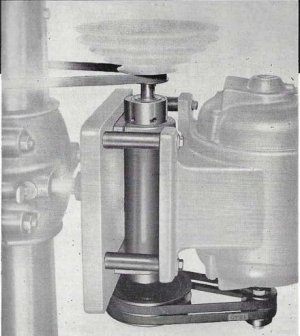View attachment 425225
This is just "mocked" up, the pulley on the motor is just sitting on the shaft, not all the way down
The first thing that I'm seeing is that you appear to have four speeds on the spindle, four speeds on the idler, and three on the motor. That screams to me that the motor and motor pulley got changed at the same time. Part of the "magic" of these stacked pulleys is that they're a specific size in relation to each other, so the tensioner comes out right in any speed. That might be an issue.
Looking at the available speeds you have, I would suspect that if you have the motor pulley mounted high, with the smallest pulley driving the largest idler pulley, (highest belt position) and the smallest idler pulley driving the largest spindle pulley, (lowest belt position) you "should" be at or about a hundred RPM. If you don't have the actual RPM nailed down yet, you know the RPM of the motor- Put the belts on the slowest speed, sharpie mark the spindle and the motor pulleys, and turn the motor pulley by hand, and count the motor rotations per one spindle rotation to get an approximate ratio. Knowing what speed you have right now might be key information, as if you're already in the hundred RPM area (I'm visually estimating), or even in the sub 200 RPM area, I think any big upgrades are going to be well past the point of diminishing returns.
Not to knock down a project to build exactly what you want. If that's the point and the purpose, then heck yeah, all in. But if the purpose is to make holes, and you're under 200 RPMs with a horsepower and a half..... You can do a lot with that.


